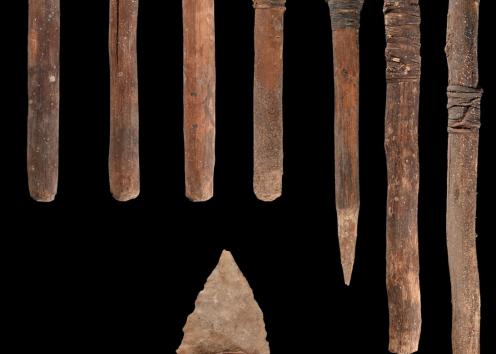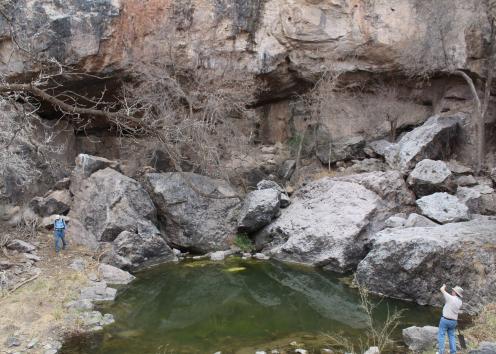San Esteban Rockshelter

The San Esteban Rockshelter is in the arid Trans-Pecos region of southwest Texas. The site is situated along Alamito Creek, a tributary of the Rio Grande. A spring-fed tinaja occurs in front of the rockshelter. The combination of a shelter and perennial water source probably made San Esteban an important point on the landscape for past Indigenous people and the more recent occupations of Anglo/Hispanic people. Though this site was pot-hunted in the past, the many large boulders that spalled from the ceiling preserved pockets of shelter deposits. The San Esteban Rockshelter is a significant locality with remarkable preservation of organic materials and the potential for Early Paleoindian and pre-Clovis age deposits. Since the summer of 2019, Odyssey has supported field investigations at San Esteban Rockshelter in partnership with the Center for Big Bend Studies (CBBS) at Sul Ross State University.
Odyssey Fieldwork at San Esteban
In 2019, Odyssey conducted a preliminary archaeological investigation of San Esteban. The primary objective was to determine the presence or absence of Early Paleoindian and/or pre-Clovis materials. The results of this fieldwork revealed extensive disturbance by amateur digging and collection as well as intact deposits.
In the summer of 2020, Odyssey continued testing at the San Esteban Rockshelter, opening up a new excavation area deeper into the shelter and between fallen boulders. The 2020 excavations in the “Sandal Shaft” revealed intact sedimentary and archaeological deposits that span the Holocene and may date back to ca. 15,000 years ago. Also recovered in the Sandal Shaft were six atlatl foreshafts and darts dating to ca. 6,200 cal yr B.P., potentially representing the earliest atlatl cache in the Americas. More significantly, a hearth-like feature containing burned and unburned bird eggshells dated to ca. 15,200 cal yr B.P., suggesting potential for a pre-Clovis occupation. Block B was expanded, revealing more intact deposits dating from the post Euro-American contact period to the Late Archaic.
Fieldwork in 2021 included collecting sediment samples and for pollen, phytolith, and micromorphological analysis. New excavation blocks were opened to explore additional areas in this large rockshelter, including the front of the shelter and below partially buried rock art panels along the back wall of the shelter. Despite the magnitude of looting activities encountered in 2019 and 2020, the 2021 excavations demonstrated that there is still remarkable stratigraphic integrity at the site.
In 2022, excavations continued in Block B and the Sandal Shaft. In Block B, six 1m x 1m units were taken down until a large boulder was uncovered. Two more units to the east of the block were opened to assess whether this boulder could be removed. Excavations in the Sandal Shaft were also expanded to see whether more late Pleistocene deposits could be located and determine the integrity of the deposits. That effort revealed that although some sedimentary deposits have been mixed by packrats and other burrowing animals toward the back of the shelter wall, undisturbed Holocene and late Pleistocene deposits consisting of loess and fragments of roof fall occur in both shafts. Robust Early Archaic cultural deposits representing what appear to be two discrete occupations were recorded in the loess. The younger of the two Early Archaic occupations contains numerous atlatl foreshafts and darts dating to ca. 6,100 B.P (located in 2020). A pronghorn hide capped with a metate was found about 5 cm above the foreshafts and darts and yielded an uncalibrated radiocarbon age of 5,621±24 B.P. (D-AMS 048151); hence, it is about 600 years younger than some of the foreshafts and darts. During the final hours of excavation at San Esteban, a large thermal feature (Feature 22-15) was identified at the back of the shelter in the Sandal Shaft. A charcoal sample yielded an uncalibrated age of 9,890±30 B.P. (Beta–641842). Subsequently, a larger piece of charcoal and a condor (Gymnogyps californianus) bone fragment with a possible cutmark were sent to DirectAMS, Inc. for radiocarbon dating. Those samples yielded uncalibrated radiocarbon ages of 12,214±40 B.P (D-AMS 048149) and 12,789±51 B.P. (D-AMS 048150), respectively.
Feature 22-15 will be the focus of the 2023 Odyssey field season as it has clear potential to be a pre-Clovis hearth. A portion of the feature will be removed for micromorphological analysis, and more work needs to be done to determine the disparity between the radiocarbon dates. Also, there will be an effort to expand further back in the shelter to see whether there are associated artifacts with this early thermal feature.
San Esteban Crew 2019: Dr. Rolfe Mandel (KU Professor and Director of Odyssey), Dr. Bryon Schroeder (Director of the Center for Big Bend Studies at Sul Ross State University), Mason Niquette (KU graduate student), Beth Potter (KU graduate student), Justin Garnett (KU graduate student), Josh Collins, Chris Hord, Mason Paige Englert, Eden Meadows, and Erika Blecha.
San Esteban Crew 2020: Dr. Rolfe Mandel (KU Professor and Director of Odyssey), Dr. Lauren Norman (KU Professor), Dr. Bryon Schroeder (Director of the Center for Big Bend Studies at Sul Ross State University), Dr. Kale Bruner (Archaeology Research Assistant at the Kansas Geological Survey), Mason Niquette (KU graduate student), Josh Collins, Chris Hord, Paige Englert, Nic Redford, Kara Johannesen, Eden Meadows, and Erika Blecha.
San Esteban Crew 2021: Dr. Rolfe Mandel (KU Professor and Director of Odyssey), Dr. Lauren Norman (KU Professor), Dr. Bryon Schroeder (Director of the Center for Big Bend Studies at Sul Ross State University), Mason Niquette (KU graduate student), Lydia Sykora (KU graduate student), Beth Potter (KU graduate student), Indiana Sorrel, David Maduzia, Angus Dunn, Josh Collins, Chris Hord, Nic Redford, Kara Johannesen, and Erika Blecha.
San Esteban Crew 2022: Dr. Rolfe Mandel (KU Professor and Director of Odyssey), Dr. Lauren Norman (KU Professor), Dr. Bryon Schroeder (Director of the Center for Big Bend Studies at Sul Ross State University), Josh Collins (OARF), Chris Hord, Natalie Nickels, Caleb Latas, Angus Dunn, and Erika Blecha.


